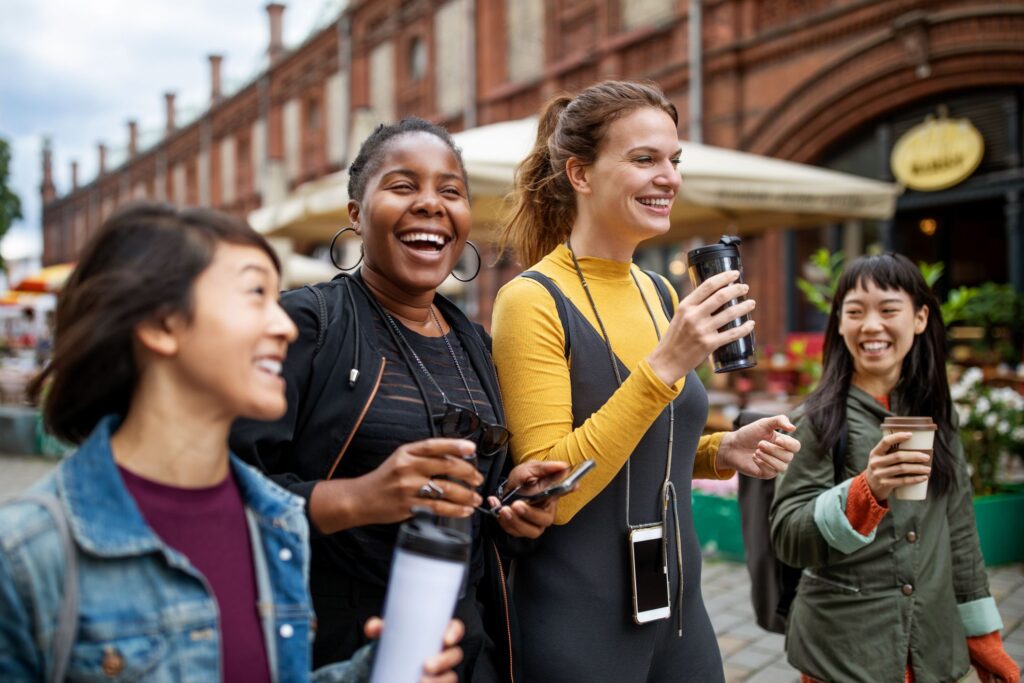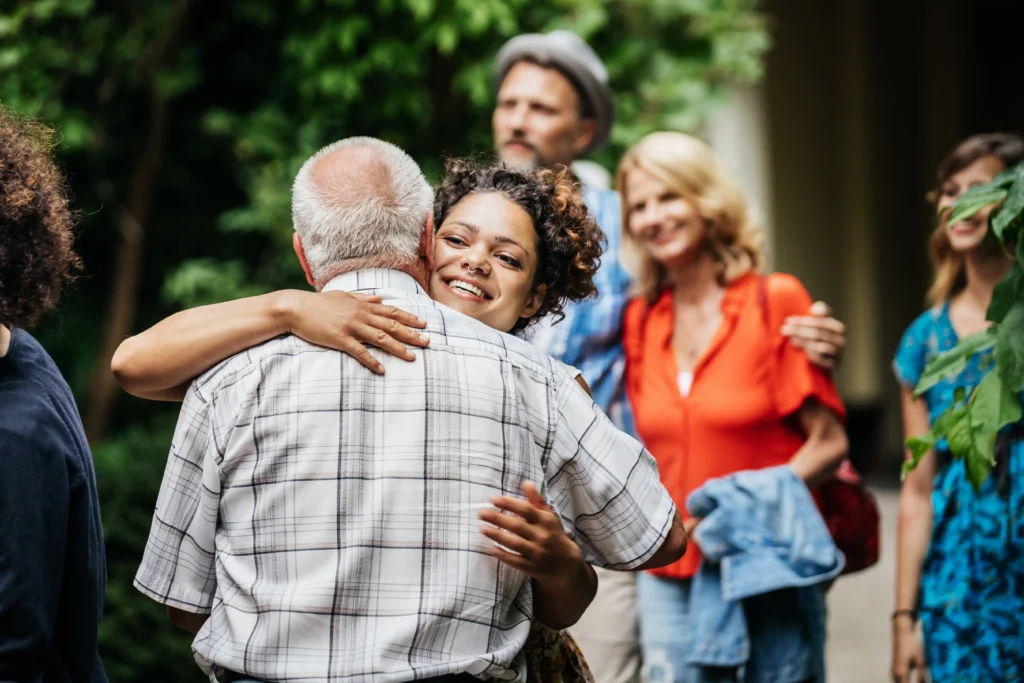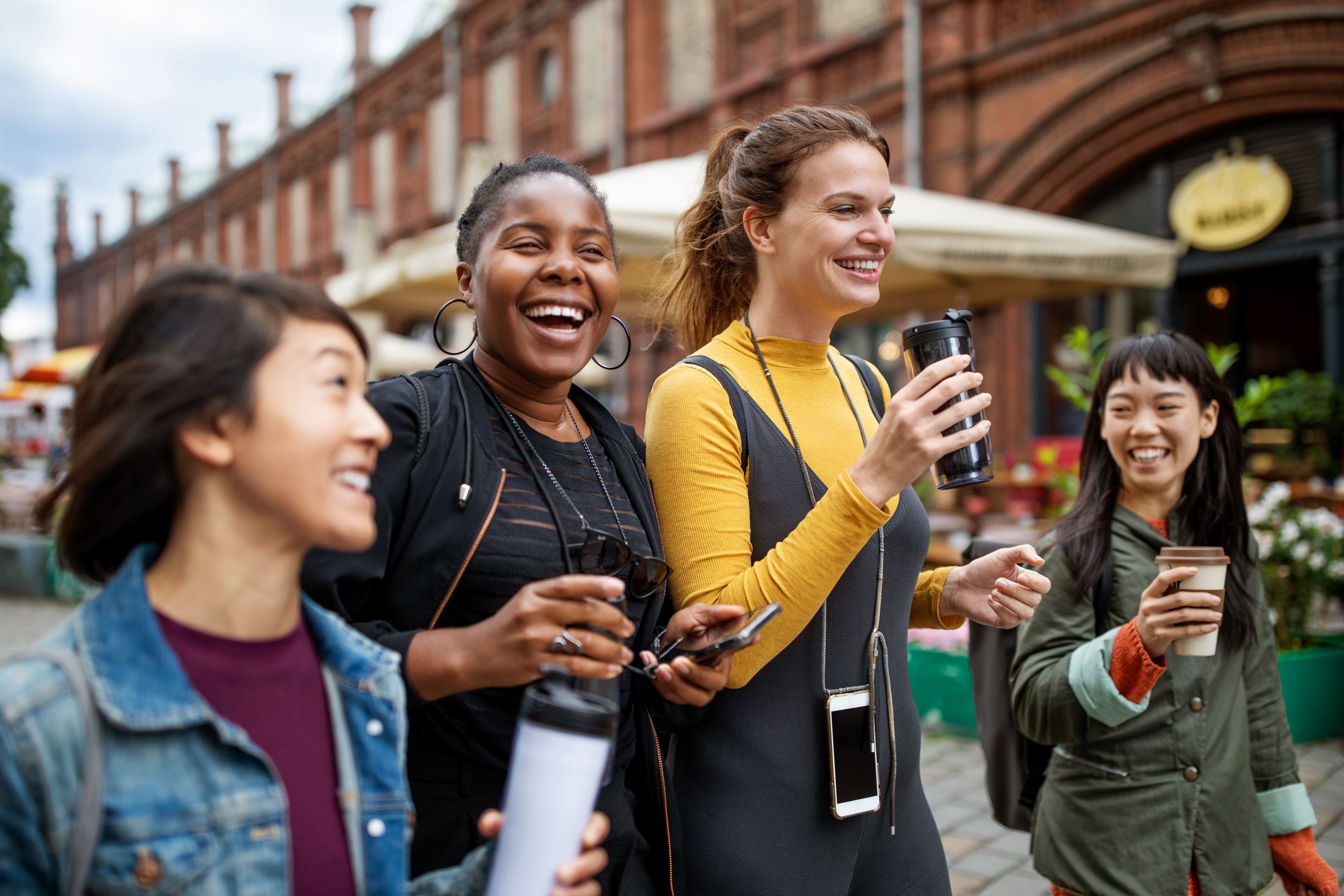“How Friendships Across Generations Enrich Our Lives and Offer Priceless Wisdom”
A Connection That Goes Beyond Time
Have you ever stopped to think about how friendships between different generations can enrich our lives? We often surround ourselves with people of the same age, with similar experiences and worldviews. But what if I told you that some of the most valuable life lessons can come from someone who saw the world before you were even born? Or from someone who has just arrived in it, with a fresh and bold perspective? Intergenerational friendship is a hidden treasure, and today, we’re going to explore why it is so valuable and how it transforms us for the better.
The Impact of Friendships Between Generations
Intergenerational friendship is not just an exchange of casual conversations; it is a bridge between the past and the present, filled with unique experiences, valuable lessons, and new perspectives. In a world where technology shortens distances but sometimes creates emotional barriers, these connections can be a breath of humanity, bringing a deeper understanding of life and society.
Friendships between different generations have a transformative impact on both older and younger individuals. For younger people, being in contact with someone more experienced is like gaining access to a living treasure of stories, lessons, and advice—something that books and social media could never fully provide. At the same time, older individuals experience a new breath of vitality, challenged to see the world through a fresh and innovative lens.
Sharing experiences fosters empathy. Younger people begin to understand that the challenges they face today—career struggles, emotional insecurities, or even existential doubts—have already been lived by those who came before them. And the most fascinating part? Discovering that there is wisdom in overcoming these obstacles, creating a sense of belonging and continuity.
On the other hand, older individuals rediscover their relevance in the modern world. Aging often brings a sense of invisibility, but forming bonds with younger people replaces those feelings with motivation and purpose. The exchange of knowledge goes beyond mere small talk—it becomes a channel for sharing technology, social changes, and cultural shifts, helping to build a deeper mutual understanding.
Moreover, these friendships provide emotional and even physical benefits. Studies show that people who maintain meaningful connections with different generations experience lower levels of stress, anxiety, and depression, along with greater longevity. Human connection acts as a natural remedy against loneliness, bringing well-being and emotional balance to both sides.
Therefore, intergenerational friendships are not only beautiful and inspiring—they are essential for building a more empathetic, connected, and balanced society. They challenge prejudices, break down barriers, and build bridges between yesterday and tomorrow, showing that, in the end, what truly unites us is not age, but the ability to learn and grow together.
Imagine a young person teaching an elderly individual how to use a smartphone, while that elderly person shares stories from a time when handwritten letters were eagerly awaited. This exchange is not just informative—it is transformative.

Young People and the Energy of Innovation
Young people are driven by an almost irresistible force: the energy of innovation. With an open mind for the new and an innate willingness to explore the unknown, they have the ability to turn challenges into opportunities and ideas into revolutions. This vibrant characteristic makes young people natural agents of change, driving progress in various areas of society.
In intergenerational friendship, this innovative energy acts as a catalyst for the renewal of ideas and practices. When interacting with older generations, young people share their enthusiasm for new technologies, emerging trends, and alternative ways of seeing the world. This exchange creates an environment where tradition and modernity meet, striking a balance that enhances the growth of both sides.
Older individuals, often accustomed to a more stable and structured way of life, find in young people a source of inspiration for reinvention. Whether learning new digital skills, discovering new forms of communication, or even finding new ways to navigate the challenges of the modern world, having a younger friend can be the push they need to continue evolving.
At the same time, young people benefit greatly from this exchange. Although they carry the fire of innovation, they often lack the wisdom gained through experience. The broader and more thoughtful perspective of older individuals helps avoid the pitfalls of youthful impulsiveness, teaching that innovation without reflection can lead to avoidable mistakes. Thus, intergenerational friendship becomes a safe space for young people to test their ideas and refine their approaches.
Furthermore, the innovative mindset of young people is reflected in their ability to challenge outdated standards and bring creative solutions to old problems. In an increasingly dynamic world, this skill is crucial for societies to evolve sustainably. The exchange of ideas between generations ensures that the past is respected, the present is valued, and the future is built with intelligence and innovation.
The impact of this exchange can be felt in all areas of life, from family relationships to the corporate world. Companies that encourage generational diversity in their teams notice that the most effective solutions arise from the combination of experience and innovation. Similarly, friendships between young and old help break down prejudices and build a more inclusive society, where all voices have space and importance.
Therefore, intergenerational friendship not only allows young people to share their innovative energy, but also gives them the opportunity to learn from the past, ensuring that progress is sustainable, humane, and truly meaningful.
For example, imagine a 70-year-old woman rediscovering her love for painting because a 20-year-old friend encouraged her to share her artwork on Instagram. Suddenly, what was once just a hobby becomes a revived passion, opening up a new world of possibilities before her.

The Elderly and the Wisdom of Experience
If the young are driven by the energy of innovation, the elderly are guided by the wisdom of experience. They carry with them a wealth of life experiences, lessons, and reflections that transcend fads and superficialities. Longevity brings a sharper perception of life, shaped by successes, failures, challenges overcome, and unforgettable moments
In intergenerational friendships, the wisdom of the elderly becomes an invaluable source of practical advice and mature perspectives. Unlike the instant information found on the internet, the knowledge acquired through experience comes with depth, nuances, and empathy. This type of learning cannot be found in books or tutorials but in the real-life experiences of those who have gone through different phases of life.
Moreover, older individuals tend to have a broader and more thoughtful perspective on events. They understand that life’s challenges are cyclical and that many difficulties faced by young people have already been experienced by previous generations. This calmer and more resilient outlook can serve as a balancing point for those dealing with the uncertainties and anxieties typical of youth.
Another valuable aspect is the ability of the elderly to teach the importance of time and patience. In a fast-paced world, where everything seems to need to happen immediately, they are a living reminder that life should be appreciated with calmness and wisdom. Their stories and advice act as a compass, helping young people avoid unnecessary mistakesand make better decisions.
Finally, the elderly also greatly benefit from these friendships. Feeling heard and valued strengthens their self-esteem and connection with the modern world. Interaction with young people keeps them active, updated, and emotionally healthier, creating a virtuous cycle where both grow and evolve together.
Thus, friendship between generations becomes a true gift, where the vigor of youth and the wisdom of experiencecomplement each other harmoniously, building bonds that enrich the lives of all involved.
The Emotional and Social Impact of Intergenerational Friendships
In times of fast and fleeting connections, a friendship between people of different ages brings something essential: a genuine bond, based on mutual respect and admiration. This exchange is not only enriching from an intellectual perspective but is also a powerful antidote against loneliness, both for the elderly and for the young.

How to Build and Cultivate Intergenerational Friendships
Creating and maintaining intergenerational friendships may seem challenging at first, but these connections happen naturally when there is openness to mutual learning and a willingness to share experiences. Here are some practical and effective ways to build and strengthen these bonds:
- Seek Interactions in Diverse Environments
The first step to fostering friendships between different generations is to expose yourself to environments where this interaction can occur naturally. Participating in community groups, volunteer work, cultural events, and interactive spaces like book clubs, churches, and workshops are excellent ways to meet people of different ages. Additionally, mentorship programs and social projects aimed at knowledge exchange between young and elderly individuals offer valuable opportunities to create genuine bonds. - Break Prejudices and Stereotypes
Generational biases can often prevent the formation of meaningful friendships. Young people may believe that older individuals are outdated or rigid, while seniors may view youth as immature or uninterested. To build genuine relationships, it is essential to break these stereotypes and see each person as a unique individual, with stories, dreams, and skills to share. - Share Interests and Activities
A great way to strengthen intergenerational friendships is to find common activities. This can include a shared interest in music, movies, cooking, sports, or technology. Teaching and learning together creates an enriching dynamic: the elderly can pass on wisdom and techniques, while the young can bring new perspectives and innovations. Mutual learning fosters admiration and respect, making the friendship even stronger. - Practice Open and Empathetic Communication
Communication is the foundation of any relationship, and in intergenerational friendships, it becomes even more important. Being open to listening to past stories, understanding challenges, and respecting different viewpoints helps to create a trusting environment. Similarly, expressing your own experiences and opinions in a respectful manner strengthens the bond, making the relationship more balanced and authentic. - Value Small Moments and Gestures of Affection
Friendships are built on everyday details. A spontaneous phone call, an invitation for coffee, or a simple message asking how someone is doing—these small gestures make all the difference. Demonstrations of care and genuine interest create a sense of belonging and show that the friendship is valued, regardless of age differences. - Learn to Handle Differences and Conflicts
It is natural for any friendship to have moments of disagreement. Among different generations, there may be diverging values, habits, and worldviews. However, the key to maintaining a lasting friendship is to handle these differences with respect and maturity. Instead of trying to change the other person, focus on understanding and accepting that everyone has their own journey and experiences. - Encourage Family and Community Interaction
Many intergenerational friendships emerge within families or communities. Grandparents and grandchildren, uncles and nephews, longtime neighbors—these relationships can be strengthened through shared moments and meaningful exchanges. Creating traditions like sharing meals, storytelling, and participating in joint activities helps strengthen these bonds, making the relationship more natural and enriching. - Use Technology to Strengthen Connections
Technology, which often seems to separate generations, can actually be used to bring them closer together. Teaching an older person to use social media, messaging apps, or video calls can facilitate communication and keep the friendship active, even from a distance. Likewise, young people can benefit from learning analog skillsfrom the elderly, such as handwriting, gardening, or even map reading. - Be Patient and Cultivate Friendship Over Time
The most valuable friendships are those built over time. Creating deep bonds requires patience, presence, and dedication. Allowing the friendship to grow naturally, without rush, and respecting the other person’s pacemakes the connection more authentic and lasting.
Building friendships between different generations is a transformative process that expands horizons and enriches the lives of all involved. When there is willingness to learn, share, and respect, these relationships become endless sources of knowledge, love, and mutual support. How about starting an intergenerational friendship today? You might be surprised by the lessons and joys this connection can bring!

The Future of Friendships Between Generations
The world is changing rapidly, and with it, the ways in which intergenerational friendships develop and evolve. In the past, relationships between people of different ages were more common within families and local communities. Today, technology, new lifestyles, and cultural shifts are reshaping these bonds in unprecedented ways. But what can we expect for the future of these friendships? How will they transform, and what role will they play in society?
Technology as a Bridge Between Generations
Technology has become a powerful ally in bringing different generations closer together. Through social media, video calls, and messaging apps, grandparents can connect with grandchildren, experienced mentors can share knowledge with young professionals, and friends of different ages can maintain constant contact regardless of geographical distance.
In the future, artificial intelligence and augmented reality are expected to create even more possibilities for interaction, fostering shared experiences such as gaming, online learning, and even virtual meetups. As communication interfaces advance, generational barriers will continue to shrink, making interactions between people of different ages more natural and fluid.
The Growth of Intergenerational Communities
There are already initiatives that encourage interaction between different generations, such as co-living spaces for young and elderly people, community hubs designed for experience exchange, and social projects that promote mutual learning. In the future, these initiatives are likely to expand, creating new formats of intergenerational communitieswhere learning, coexistence, and mutual support become essential for healthier aging and a more enriched youth.
With increasing life expectancy, many elderly individuals will seek not only companionship but also ways to stay active and integrated into society. At the same time, younger generations can benefit from the wisdom and emotional stabilitythat friendships with older people offer.
The Revaluation of Wisdom and Youth
For a long time, generational gaps have created distance due to different worldviews. However, there is a growing trend of revaluing the experience of older generations, as well as the innovation and energy of younger ones. This complementarity will be essential for a future where knowledge is not only acquired in schools and universities but also through direct interaction with people who have rich stories and experiences to share.
More and more, companies and organizations are recognizing the value of age diversity, promoting reverse mentorships where younger employees teach digital skills to older colleagues while learning about leadership and resilience in return. This model is expected to become even more common, strengthening intergenerational bondsacross various aspects of life.

The Importance of Empathy and Coexistence
The future of intergenerational friendships will depend on people’s ability to practice empathy, patience, and genuine interest in others. Although cultural and technological differences may seem like obstacles, they also represent opportunities for personal and collective growth.
Educational projects and social programs that encourage intergenerational interaction will play a crucial role in building a more harmonious society. Accepting differences, respecting each other’s journeys, and finding common ground will be essential for these relationships to grow and become even more meaningful in the future.
The future of intergenerational friendships is promising, filled with possibilities that can transform how we connect and learn from one another. As society progresses, interacting with different generations will become a powerful tool for personal, professional, and emotional development. After all, when different ages come together, they create a world that is richer, more balanced, and full of mutual learning.
Friendship Has No Age, Only Value
At the end of the day, it doesn’t matter if you’re 20 or 80 years old—what truly matters is your willingness to learn and share. Intergenerational friendships are a gift that transcends time, connects hearts, and reminds us that life is a much richer journey when shared.
If you don’t have a friend from a different generation yet, why not open yourself up to the possibility? That unexpected conversation might just teach you something you never imagined.







